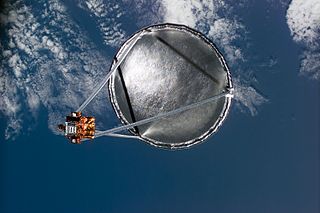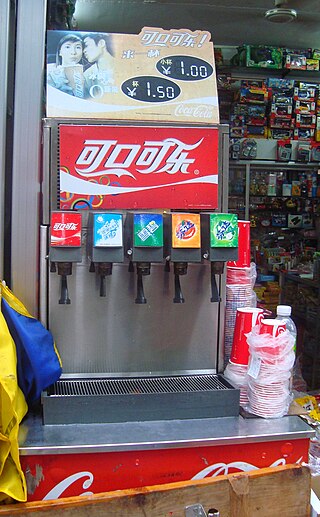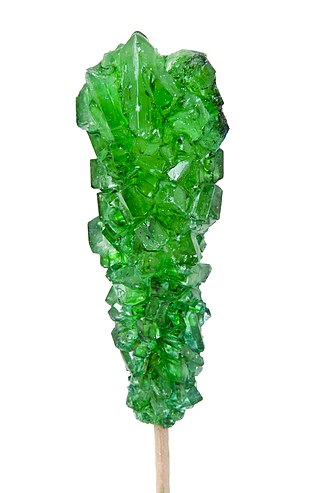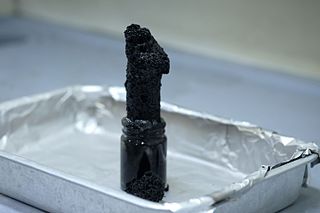
A soft drink is any water-based flavored drink, usually but not necessarily carbonated, and typically including added sweetener. Flavors used can be natural or artificial. The sweetener may be a sugar, high-fructose corn syrup, fruit juice, a sugar substitute, or some combination of these. Soft drinks may also contain caffeine, colorings, preservatives and other ingredients.

Carbonated water is water containing dissolved carbon dioxide gas, either artificially injected under pressure or occurring due to natural geological processes. Carbonation causes small bubbles to form, giving the water an effervescent quality. Common forms include sparkling natural mineral water, club soda, and commercially produced sparkling water.

STS-77 was the 77th Space Shuttle mission and the 11th mission of the Space Shuttle Endeavour. The mission began from launch pad 39B from Kennedy Space Center, Florida on 19 May 1996 lasting 10 days and 40 minutes and completing 161 revolutions before landing on runway 33. The defense and aerospace technology company L'Garde was responsible for the design and manufacture of the Antenna in the Inflatable Antenna Experiment, a key component of the STS-77 mission.

Mentos are a brand of packaged scotch mints or mint-flavored candies sold in stores and vending machines. First produced in 1932, they are currently sold in more than 130 countries worldwide by the Italian-Dutch corporation Perfetti Van Melle. The mints are small oblate spheroids, with a slightly hard exterior and a soft, chewy interior.

A soda fountain is a device that dispenses carbonated soft drinks, called fountain drinks. They can be found in restaurants, concession stands and other locations such as convenience stores. The artifact combines flavored syrup or syrup concentrate and carbon dioxide with chilled and purified water to make soft drinks, either manually, or in a vending machine which is essentially an automated soda fountain that is operated using a soda gun. Today, the syrup often is pumped from a special container called a bag-in-box (BiB).

Effervescence is the escape of gas from an aqueous solution and the foaming or fizzing that results from that release. The word effervescence is derived from the Latin verb fervere, preceded by the adverb ex. It has the same linguistic root as the word fermentation.

Pop Rocks, also called popping candy, is a candy owned by Zeta Espacial S.A. Pop Rocks ingredients include sugar, lactose, and flavoring. It differs from typical hard candy in that pressurized carbon dioxide gas bubbles are embedded inside of the candy, creating a small popping reaction when it dissolves.

Beer head is the frothy foam on top of beer and carbonated beverages which is produced by bubbles of gas, predominantly carbon dioxide, rising to the surface. The elements that produce the head are wort protein, yeast and hop residue. The carbon dioxide that forms the bubbles in the head is produced during fermentation as yeasts break down sugar-rich molecules to produce ethanol and carbon dioxide. The carbonation can occur before or after bottling the beer. If the beer continues fermenting in the bottle, then it naturally carbonates and the head is formed upon opening and/or pouring the beer. If the beer is pasteurized or filtered then the beer must be force carbonated using pressurized gas.

In thermodynamics, nucleation is the first step in the formation of either a new thermodynamic phase or structure via self-assembly or self-organization within a substance or mixture. Nucleation is typically defined to be the process that determines how long an observer has to wait before the new phase or self-organized structure appears. For example, if a volume of water is cooled below 0 °C, it will tend to freeze into ice, but volumes of water cooled only a few degrees below 0 °C often stay completely free of ice for long periods (supercooling). At these conditions, nucleation of ice is either slow or does not occur at all. However, at lower temperatures nucleation is fast, and ice crystals appear after little or no delay.

The soda siphon, also known as the seltzer bottle, siphon seltzer bottle, or just siphon) is a device for storing and dispensing carbonated beverages while maintaining the internal pressure, thereby preventing it from going flat. The carbonated beverage is dispensed using the internal pressure of the bottle, so the setup is not a true siphon in its operation.

Steve Spangler is an American television personality, author and STEM teacher. Steve served as the CEO of Steve Spangler Science until 2018 when the company was sold to Really Good Stuff, LLC, a division of Excelligence Learning Corporation. Spangler posted the first Diet Coke and Mentos video on YouTube in September 2005 and his 2002 televised demonstration of the eruption went viral, launching a chain of several other Diet Coke and Mentos experiment viral videos. He earned two Heartland Emmy Awards and a total of five Emmy nominations. Spangler is an inductee of the National Speakers Association Speaker Hall of Fame.

The blue bottle experiment is a color-changing redox chemical reaction. An aqueous solution containing glucose, sodium hydroxide, methylene blue is prepared in a closed bottle containing some air. Upon standing, it spontaneously turns from blue to colorless due to reduction of methylene blue by the alkaline glucose solution. However, shaking the bottle oxidizes methylene blue back into its blue form. With further shaking, this color-change cycle can be repeated many times. This experiment is a classic chemistry demonstration that can be used in laboratory courses as a general chemistry experiment to study chemical kinetics and reaction mechanism. The reaction also works with other reducing agents besides glucose and other redox indicator dyes besides methylene blue.

Elephant's toothpaste is a foamy substance caused by the rapid decomposition of hydrogen peroxide using potassium iodide (KI) or yeast and warm water as a catalyst. How rapidly the reaction proceeds will depend on the concentration of hydrogen peroxide.
EepyBird is an entertainment company best known for creating the viral video "The Extreme Diet Coke & Mentos Experiments" which won the first ever Webby Award for Viral Video in 2007 and was named "Online Game Changer of the Decade" in December 2009 by the readers of GoViral.com as "the most significant online marketing campaign of the decade."
Princeton High School is a public secondary school located on 807 Eighth Avenue South in Princeton Minnesota, United States. The school is part of the Princeton Independent School District 477.

The Soda Springs Geyser is an artesian well drilled into the carbonated aquifer that lies beneath Soda Springs, Idaho. Thousands of natural springs in the area were a landmark on the Oregon Trail.

The chemical compounds in beer give it a distinctive taste, smell and appearance. The majority of compounds in beer come from the metabolic activities of plants and yeast and so are covered by the fields of biochemistry and organic chemistry. The main exception is that beer contains over 90% water and the mineral ions in the water (hardness) can have a significant effect upon the taste.

Carbon snake is a demonstration of the dehydration reaction of sugar by concentrated sulfuric acid. With concentrated sulfuric acid, granulated table sugar (sucrose) performs a degradation reaction which changes its form to a black solid-liquid mixture. The carbon snake experiment can sometimes be misidentified as the black snake, "sugar snake", or "burning sugar" reaction, all of which involve baking soda rather than sulfuric acid.

Glowmatography is a laboratory technique for the separation of dyes present in solutions contained in glow sticks. The chemical components of such solutions can be chromatographically separated into polar and nonpolar components. Developed as a laboratory class experiment, it can be used to demonstrate chemistry concepts of polarity, chemical kinetics, and chemiluminescence.




















